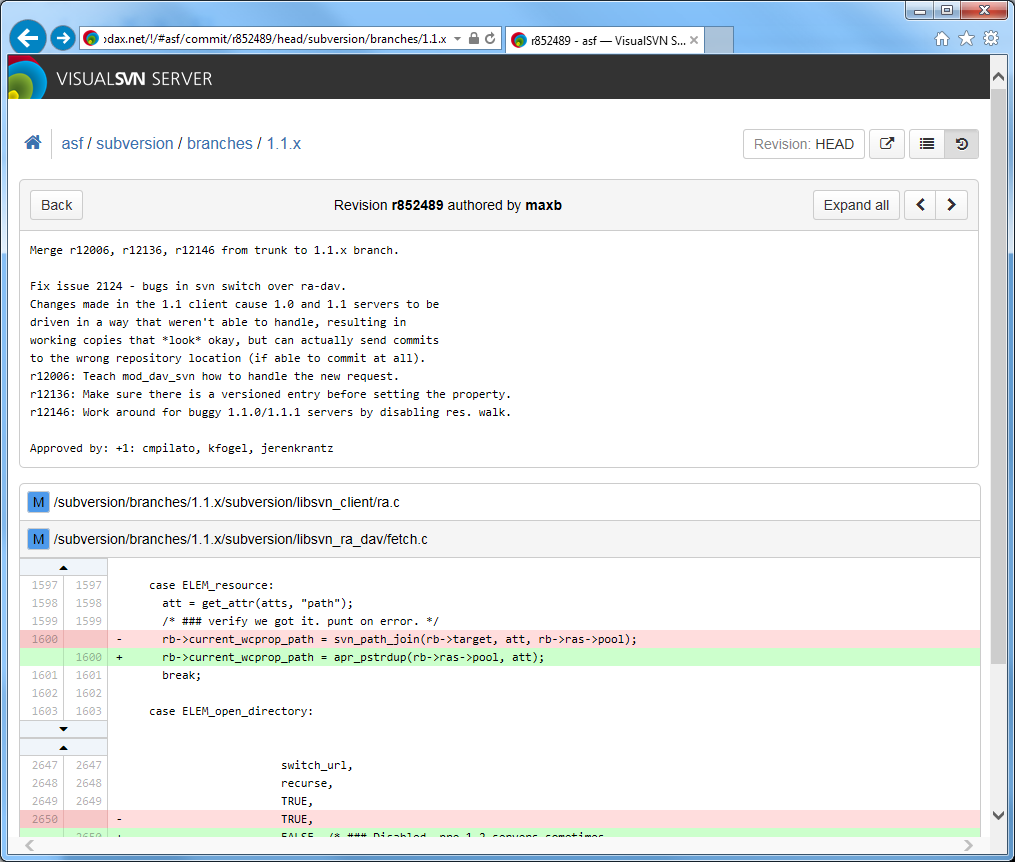

Keywords are informational strings that can be added to files managed by SVN. If you attempt to add a symlink, Darcs will issue a warning and will not add it. Darcs currently doesn’t support arbitrary file properties, any special file permissions or symlinks (cross-platform support for the latter two would involve considerable amount of work). Support for file permissions and symlinks Subversion uses “svn:executable” and “svn:special” file properties to support executables and symlinks.

You can check out only what you need and never see changes other users are making to other parts of the repository. Partial repository checkout Subversion allows you to check out working copies of a portion of a tree. With darcs, this process is fully automated, just use darcs send and you will be interactively prompted for which patches to send.
#Subversion net Patch
As you record, push or pull patches, you are given the opportunity to review details, be selective, and create a workflow that suits you.ĭarcs makes it easier to accept contributions from non-commiters E-mailing a patch is the usual alternative to directly committing into the project. In a lot of cases, merging requires no user input.ĭarcs is more interactive, creating more efficient workflows Darcs is easy to learn and pleasant to use because it is interactive. You can selectively move patches between branches, and to/from the server. Simple merging and branching A new branch is just another local copy of the repository.
#Subversion net Offline
Moreover, creating a new central repository is as easy as running darcs clone from one of the working copies.ĭarcs users can work offline and still record changes as they are made whereas SVN does not provide a way to record your work when you don’t have access to your server. Advantages of darcs over SVNĮvery working copy of the repository is a fully functional repository whereas in SVN, there is one central repository and one or more working copies that need to access the repository for common operations.ĭarcs behaves gracefully when the server/central repository fails With Darcs, if your “server” gets messed up for whatever reason, your users can still exchange patches amongst themselves. That is probably the easier way.This page is aimed at Subversion (SVN) users who want to know how Darcs differs from it. For Linux servers, SVN packages are usually available from the distribution. For "", the current versions of the graphical TortoiseSVN client provide options for installing the command line tools, including "svnserve".
#Subversion net update
We recommend that you update this because SVN developers no long offer support for this version and earlier.įor Windows servers, download the installation packages from the Internet, for example from"" or "". There should not be any problems with an existing server of version 1.8. Select a current version (example: version 1.9.x) when installing the SVN server for the first time.

Make sure you have a functioning backup.įor CODESYS SVN as the SVN client, it does not matter on which operating system the server runs.
#Subversion net software
Update the installed software in regular intervals and secure the server against external access. Make sure that failsafe hardware is used that is intended for operation as a server. We recommend that you employ a productive SVN server as part of the IT infrastructure that is monitored and maintained by experts. Note: We strongly advise you to use this variant by means of network sharing for common access. This variant is intended for testing purposes and administrator access only. However, it has limited capabilities for access control within a SVN repository.ĭirect access to an SVN repository using the file:// protocol. This is primarily useful when the clients also run on Linux/Unix. This variant uses the Secure Shell from Linux/Unix for implementing access control and encryption. Access takes place via the Internet protocol or its encrypted variant This type of installation is applied frequently for public SVN servers or via SVN servers reached through the Internet. This is SVN integrated into the Apache web server. It is usually applied internally for company networks or in connection with VPN. Access takes place using the efficient svn:// protocol. This is the simplest variant for installing an SVN server. In addition, one server installation can manage multiple SVN repositories. An SVN repository can normally be enabled easily at the same time via several of the following variants. Several variants of SVN servers are currently available.


 0 kommentar(er)
0 kommentar(er)
